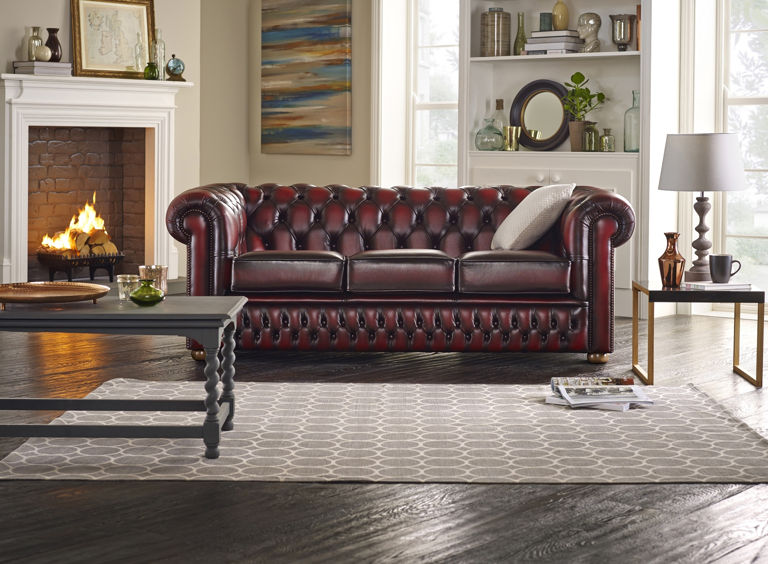The British brand conquering the US one sofa at a time

Posted: Tue 9th Aug 2016
Bolton-based Sofas By Saxon exports British-made sofas and chairs all around the world. One of the company's most successful markets is the U.S.
Here, managing director Matt Deighton discusses the story behind the business and shares insights in to how the company has made a success of exporting across the pond.
How did Sofas by Saxon start?
The business was founded in 1982 by a husband and wife team. They took over and built the company up from being an already-existing upholstery business that was due to close as the owner was retiring.
What start-up challenges did you face and how did you overcome them?
The founders had no previous experience of manufacturing furniture, so there was a very steep but exciting learning curve to begin with.
This meant they had to immerse themselves in the business and rely heavily on the staff they had inherited while they developed an understanding of how to run this kind of business. This has served the company well and some of those same employees from the beginning are still with the company more than 34 years later.
To start with, we sold furniture to retailers who would then sell it on at a profit. However, the owners wanted to cut out the middleman, so one of the early challenges involved shifting their focus to sell directly to the general public.
This approach was rather innovative in 1982. It was well before the days of online sales, of course, so mail order business was born through advertising in national newspapers and holding exhibitions at venues across the country each weekend.
What research did you do before first expanding overseas?
The majority of the initial research related to logistics. This included the likes of finding reliable shipping partners that could deliver furniture and working out what kind of packaging would protect exported products best. Methods and terms of payment had to be worked out. Plus, import procedures and customs charges had to be considered.
Why did you decide to export to the US and how successful has it been?
The decision to export to the US was largely based on the fact that we wanted to access a larger market of people who appreciate traditionally-crafted English furniture. The lack of a language barrier is also beneficial. The US is actually one of our most successful export markets now and promises future growth.
What research did you do before expanding into the US?
Again, a lot of it was about logistics. Given the size of the US, you need to have the right partners who can handle the importing and distribution. Thankfully, we have developed exceptional links in recent years.
We also researched the import regulations and associated costs so we could let customers know exactly how much they should be expecting to pay. The last thing people want is a hidden compulsory charge once their order arrives in the country. Finally, we tested the scale of the opportunity by conducting some online research.
What three tips would you give other entrepreneurs who are looking to expand to the US?
Depending on the nature of your business, conduct some initial research that involves testing the market. I'd recommend using online advertising via the likes of Google AdWords. For a relatively small investment, this will allow you to establish whether there is potential in the US for your product or service.
Understand that although there isn't a language barrier when dealing with the US, you can't overlook the cultural differences between there and the UK. These can be subtle in some states and more pronounced in others.
Ensure you have the necessary logistics in place to deliver a customer experience that is just as good as the one you offer to the market at home.
How did you find your partners in the US?
Finding partners to work with in the US required a combination of patience, persistence and a bit of luck. The internet is a wonderful tool when it comes to finding and researching potential partners. Also, we've found that looking into who your competitors are working with can give you a lot of helpful information.
It's a good idea to start small and test out potential partners by contacting them with basic queries. This way, you'll be able to gauge their response times and levels of expertise. The right partner will want your arrangement to be mutually beneficial and, once in place, will be incredibly helpful.
What cultural differences have you had to deal with?
The US covers more than nine million square kilometres, so it's not surprising that some regions are very different to others. Not only are there differences in the climates and landscapes, but also in the people who inhabit different regions.
For us, different climates tend to have a big effect on the types of products we sell. For example, leather sofas tend to be favoured in cooler areas, whereas those who live in warmer states often prefer fabric. Plus, there are areas within the US where people are more interested in owning pieces of traditional furniture, such as Chesterfield sofas, in general.
Logistics also plays a part, as it's often cheaper to ship our furniture to places on the East Coast than to the West Coast. Of course, there are no hard and fast rules, but you should definitely think about all of these things when considering selling to the US.
How does your website engage with American customers?
We've recently made some improvements to our website in an effort to engage more with our US customers. Our prices are now available in dollars, for example, and we've included imperial measurements. We've also made it very clear that we regularly ship to the US and that our deliveries have all been well-received by our customers over there.
Learn how to sell to customers in the US
Knowledge is power! Equip yourself with the right tools to conquer the American market. Download our guide tailored for small businesses like yours
Get business support right to your inbox
Subscribe to our newsletter to receive business tips, learn about new funding programmes, join upcoming events, take e-learning courses, and more.
Start your business journey today
Take the first step to successfully starting and growing your business.
Join for free

